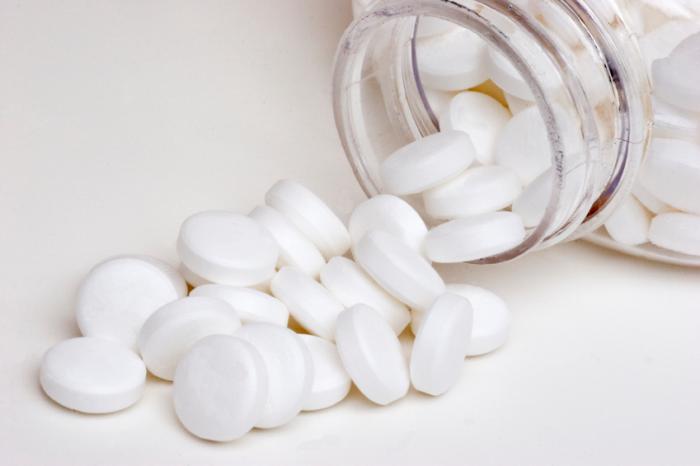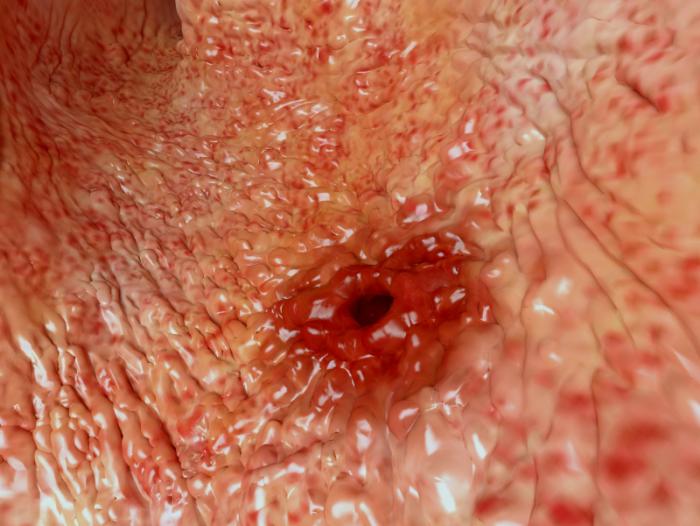Symptoms such as pain and indigestion, felt where food sits in the stomach, might lead to worries about an ulcer.
Stomach ulcers are damage to a small area in the lining of the stomach. Ulcers can also happen just below the stomach.
The symptoms of stomach ulcers vary, although there is usually pain. Symptoms can easily be confused with those of other problems in the gut. Doctors can help with persistent symptoms, and if the cause is an ulcer, it can be treated.
Contents of this article:
- What is a stomach ulcer?
- Stomach ulcer symptoms
- Causes of stomach ulcers
- Diagnosis and treatment
What is a stomach ulcer?
When a small area of the surface on the inside of the stomach is damaged in a certain way, this is a stomach ulcer.
Ulcers can happen just past the stomach, too – slightly lower down the gut, in the first few centimeters of the small intestine.
The cause of stomach ulcer is damage from the acid contents of the stomach. The stomach is where food first sits after passing down from the mouth.
Stomach acid and churning help with digesting food. The acid also helps protect against harm from microbes. The stomach protects itself from the acid it secretes. If this surface protection is harmed, the acid can cause damage. This damage is what results in an ulcer.
Mouth ulcers and stomach ulcers are both shallow holes in the surface of the moist tissue in these areas.
Stomach ulcer symptoms
The classic symptom of a stomach ulcer is indigestion. Doctors also call this symptom dyspepsia. Indigestion causes pain or discomfort in the stomach area. Not all stomach ulcers show this symptom.
This main symptom may feel like it is just below the chest and can be mistaken for another problem in the gut known as heartburn. Heartburn is more of a burning sensation and can occur at the same time as ulcer pain.

Pain is the main symptom of a stomach ulcer, either around the stomach or slightly higher up.
Heartburn can be caused by acid reflux or GERD. It occurs slightly higher up from the stomach and is felt in the lower part of the chest. In some cases, heartburn can be felt even higher.
Stomach ulcer symptoms tend to be more distinct than heartburn, but symptoms can still be vague. An ulcer tends to:
- Produce a burning pain, but often a precise sensation in the stomach area
- This pain is also described as a sort of “biting” or “gnawing” pain
- Many people have symptoms that are not clear or typical like the above two
- Some people describe a hungry sensation
Ulcers in the stomach tend to show slightly different symptoms and signs than those in the small intestine:
- Stomach ulcers tend to show less clear symptoms, with the pain being less consistent. Sometimes the pain is worse after eating food.
- Small intestine ulcers are more likely to produce a consistent pain. The pain can wake many in the middle of the night but is not there first thing in the morning. When the pain appears later in the day, eating food tends to reduce it.
The difference may be of interest to doctors, who may want to ensure nighttime acid is treated for small intestine ulcers.
Some stomach ulcers go unnoticed and show no typical indigestion-type pains. These ulcers are less common and tend to be diagnosed after the ulcer has started bleeding. Some ulcers can develop into the more serious problem of a hole in the stomach wall. This is known as perforation.
Stomach ulcer symptoms can change over time. However, it can be difficult to the spot the signs and symptoms of a stomach ulcer, let alone whether they have progressed.
When to see a doctor about stomach ulcer
Anyone who thinks they may have an ulcer in their stomach should consult their doctor. Any stomach symptoms that last for more than a few days or keep happening need evaluation and treatment.
It is not common, but it is especially important to get medical attention if there could have been a complication of an ulcer.
A slow-bleeding ulcer can be signaled by feeling anemic, such as being tired and breathless. More serious bleeding is an urgent medical problem, and can be signaled if blood is vomited up, or stools are black and sticky.
Perforation – a hole in the stomach – is also an emergency. Without quick treatment, the wall of the stomach can get infected. Sudden belly pain that gets worse can signal perforation, and any signs of being very unwell with infection need treatment as soon as possible.
Causes of stomach ulcers
The two main causes of ulcers of the stomach and small intestine, just past the stomach, are:

A class of painkillers known as NSAIDs can increase the risk of stomach ulcers.
- Bacteria called Helicobacter pylori
- A class of painkillers called nonsteroidal anti-inflammatories, or NSAIDs
An international group of medical reviewers has published guidance on getting rid of H. pylori for people who have this type of microbe in their gut. The Cochrane review says that roughly 1 in every 10 people in Western countries will have an ulcer in the stomach or just below it at some point in their lives.
A study published in 2010, reviewed by the Cochrane paper, suggests that the costs linked to these ulcers run to 3.1 billion dollars in the United States.
Anyone can get a stomach ulcer, but they are much less common in children. The risk in children is higher if their parents smoke or have a stomach ulcer themselves. One of the other risk factors for young people getting stomach ulcers is drinking alcohol.
NSAID drugs and stomach ulcers
A group of painkillers known as NSAIDs carries a risk of stomach ulcers. The two best-known NSAIDs are aspirin and ibuprofen.
The risk of ulcers depends on the person. Anyone taking NSAID painkillers is at greater risk if they need the drugs in high doses, or regularly for a longer term, however.
Stronger NSAIDs needed on prescription are riskier for stomach ulcers than those that can be bought over the counter.
People should always check labels and talk to a pharmacist or a doctor about any concerns with using painkillers. They may recommend an alternative such as acetaminophen.
How do NSAIDs cause stomach ulcers?
Ulcers in the stomach or small intestine can form because of the action of NSAID painkillers on an enzyme.
This action, to block COX enzyme, is helpful against inflammation. However, it also acts against the production of the mucus that lines the stomach wall.
The effect of this process means that the stomach lining is less protected from the acid it produces to help with digestion. This effect can lead to the wearing down of the stomach lining, forming an ulcer.
One way around the ulcer risk for people who still need NSAIDs might be for a doctor to prescribe separate drugs that reduce acid production in the stomach.
Diagnosis and treatment of stomach ulcers
Doctors follow the symptoms of a stomach ulcer by asking questions about how the pain feels, where and when it happens, and how frequent and long-lasting it has been. This process helps to narrow down whether there is a stomach ulcer or not.

Stomach ulcers are often treated by removing the cause of the problem.
If there are more serious symptoms such as bleeding, doctors may send for further testing. One further test may be using an endoscope camera to look at the gut lining.
If the doctor does think it is a stomach ulcer, they may try to remove the cause by:
- Helping with painkiller choices if the cause is likely to be NSAIDs
- Trying the “test-and-treat” approach if the cause could be H. pylori bacteria
The symptoms of stomach ulcers themselves can also be treated by helping protect the ulcer from acid while it heals after removing a suspected cause. Drugs a doctor could prescribe include:
- A proton pump inhibitor (PPI) or an H2-receptor antagonist
- An antacid or alginate
Complications from stomach ulcers such as bleeding or perforation are rare. Either of these complications requires urgent medical attention.